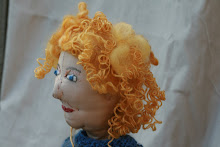 All four skeins are the same fine cotton yarn--designed for crochet, but in my mind intended for weaving. The outer two skeins are dip-dyed. The pattern of colour in the skein depends on the way I've folded the skeins before dipping them into the dye bath. the blue skein on the left was turned over after the warm blue dyeing was finished and the opposite end of the bundle of yarn was then soaked in a turquoise blue. By the way, I thread a chopstick through the looped skein and balance it on the outside of the dye pot to keep the yarn where I want it to be.
All four skeins are the same fine cotton yarn--designed for crochet, but in my mind intended for weaving. The outer two skeins are dip-dyed. The pattern of colour in the skein depends on the way I've folded the skeins before dipping them into the dye bath. the blue skein on the left was turned over after the warm blue dyeing was finished and the opposite end of the bundle of yarn was then soaked in a turquoise blue. By the way, I thread a chopstick through the looped skein and balance it on the outside of the dye pot to keep the yarn where I want it to be.The inner two skeins in the pic are cram-jar dyed. This is more random, because the skein is pressed into a confined space to combine with the dye. For the red-orange skein I first used a warm red along with about a third of the skein of yarn; then the warm yellow and as much more of the yarn as I thought would take up the amount of dye I had poured in. Finally I tipped a little bit of cool yellow over the top. The colour change is slow and fairly regular, though not as predictable as it would have been if I'd used the dip-dye technique. The blue-green skein second from the left is more jazzy. I was getting to the end of my dyes and the end of my energy for the day. I had soaked the skein in soda ash to prepare it to take the colour. When it was readyI just poured the blue into the top of the jar where the yarn had been soaking. I tipped a bit of yellow into one corner and got ready for bed. I couldn't resist having a look after half an hour or so, and found that the colour had all stayed in the top part of the skein as it was crammed into the dye pot. I turned it over and added a bit more blue dye. I decided to leave it at that. I quite like the lighter and white areas as part of the colour scheme.
As if all this variation in the rhythms of colour across the skein wasn't enough, I'm now anticipating what will happen when the yarn is turned into fabric. Whether I knit, crochet or weave it, the colours will combine again in different ways depending on the pattern I use and the size of the piece I make. In weaving, there's the added variable of the colours of two different yarns interlacing with one another. Oh, it's exciting to think of all the possibilities!


No comments:
Post a Comment